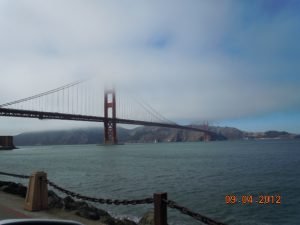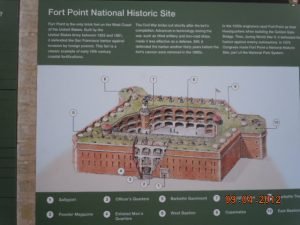If you’re visiting the San Francisco California area you’ll make a good choice by adding a stop at Fort Point to your itinerary.
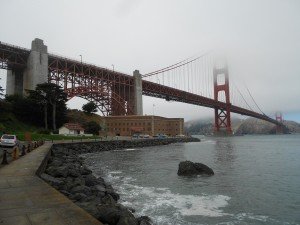
Fort Point is one of the most unique historical sites the the United States. The Fort has been called “the pride of the Pacific,” “the Gibraltar of the West Coast,” and “one of the most perfect models of masonry in America.”
A big reason why this fort is so unique has to do in where it’s located. The site of Fort Point is directly under the south end of the Golden Gate Bridge and in the Golden Gate National Parks area. Stand inside or outside the fort gate, look up and you’ll see the bottom of the bridge. There’s nothing else like it.
In 1959, a group of retired military officers and civilian engineers created the Fort Point Museum Association and lobbied for its creation as a National Historic Site. On October 16, 1970, Fort Point became a National Historic Site. Today, Fort Point is a National Historic Site administered by the National Park Service.
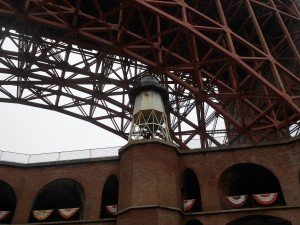
Fort Point of course was at the mouth of San Francisco Bay well before the Golden Gate Bridge. This fort represents the story of the beginnings of California as well as US Army history. The fort stands as a historical site showcasing the American military from the time of the California Gold Rush and into the 1900’s.
A Strategic Location
There may not have been a better positioned fort to protect the bay entrance. The Spaniards, the first Europeans to arrive in present day San Francisco, built the famous San Francisco Presidio as well as fortifying the cliffs where Fort Point is now located. This was all on the south side of the bay entrance. The Spaniards were concerned with encroachment from the north by both the Russians and the British and having a defense facing the Golden gate opening was preferred
The Russians and their trading operations actually had reached all the way south to around present day Bodega Bay, about 60 miles north of San Francisco. As it turned out, the Russian colony was engaged in trading as opposed to any type of colonization. The Russians were never involved in armed skirmishes with either the Spaniards or the Mexicans after them.
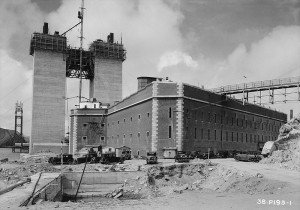
Construction in the 1850’s
Fort Point was constructed by the Americans between 1853 and 1861 as a base to protect the bay. This was during the Gold Rush era of California and during the first decade of American rule.
The final decision to build the fort came in 1850 when California became a state. At that time a series of fortifications were planned to protect the very important and busy bay. The Gold Rush changed San Francisco’s economy virtually overnight and the bay became one of the most important parts of the U.S.
The work in building Fort Point was done by some 200 workers, many unemployed miners. At it’s completion, the U.S. was in a Civil War and the fort was manned to protect against any possible Confederate attack. Military officials stated that the fort’s position and sophistication with large brick walls (seven feet thick) at the San Francisco Bay mouth was the key to the whole Pacific coast.
While Fort Point saw no action during the Civil War the possibility was always there.
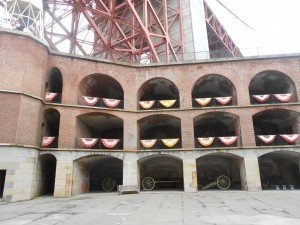
The One Time Fort Winfield Scott
Another interesting fact according to the National Park Service was that the fort was actually renamed Fort Winfield Scott in 1882 but for whatever reason the name didn’t stick. Eventually the name Winfield Scott was placed on an artillery post at the nearby Presidio. Winfield Scott was a national hero of the Mexican American War.
Turn of the Century Changes
As the years went by, many technological weapon changes took place. In 1892, the army started to construct new concrete and steel fortifications that would contain breech loading rifled guns. The era of the cannon was coming to an end. The 1906 Earthquake was obviously devastating to San Francisco and the fort wasn’t entirely spared. Fortunately it was only moderately damaged. After the earthquake, Fort Point was mostly used for training and for barracks space although the members of the 6th Artillery Coast Guard were stationed there during World War two.
See the Trips Into History articles on the links below…
The Last Days of the California Stagecoach
San Francisco’s Telegraph Hill
A Six Month Voyage Chasing for Gold
A Visit to the Gatekeeper’s Museum / Tahoe City CA
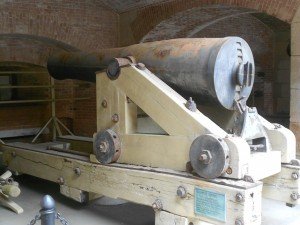
Building the Golden Gate Bridge
When you visit Fort Point today you’ll first notice how the fort is constructed directly beneath the south end of the Golden Gate Bridge. Fort Point was actually scheduled to be demolished to make way for the 1930’s bridge building. When the bridge building plans were finalized the fort was spared and construction plans called for building around the historic fort. This was a big win for historic preservation and as a result we have a fascinating site to visit taking us back to the last half of the 1800’s.
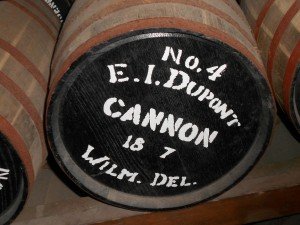
Visiting Fort Point National Historic Site
Fort Point is located at the end of Marine Drive on the Presidio of San Francisco. Getting there can be a bit tricky. If you’re coming from San Francisco proper or points south of the Golden Gate Bridge, take Highway 101 north and exit right at the Golden Gate Bridge toll plaza but before getting on bridge. Turn right at end of exit ramp and then left onto Lincoln Boulevard. Take the first left onto Long Avenue and follow onto Marine Drive and Fort Point at its end. There is parking available before getting to the fort itself.
(Article and photos copyright Trips Into History)

